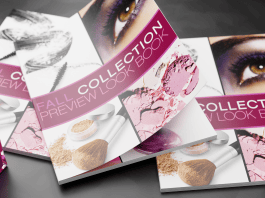Last updated on June 21st, 2024 at 10:45 am
It’s 2019 and we’re halfway into the year. Your company’s marketing team is likely implementing a well-rounded strategy, incorporating the newest ways to position your business. Consumers are faced with noise coming from every digital channel. Marketers have the hard task of cutting through this noise and relaying information about your company to consumers in an efficient and succinct way.
While online marketing strategies such as banner ads and emails face the possibility of getting blocked, there is no way to “block” print media. Print marketing is an excellent way for your campaign to be heard in today’s clamor of digital noise.

Combining Print with Digital Marketing
The best ad campaigns combine online marketing with print advertising. Print media and digital marketing can be used to bolster one another as complementary methods of reaching consumers. Print mediums can guide consumers to your site and social media platforms. This brand engagement runs online and offline.
QR Codes

QR “quick response” codes can be used on print to create a gateway to your digital presence. Since QR codes can be scanned, they are more user-friendly than providing website links. Users can scan the code with their mobile phones and directly access your website or be taken to pages where they can find special offers. The best part about QR codes is the seamless transition they create between your print mediums and online platforms.
Coupon/Promo Codes

Coupons are a staple of print advertisement and have been around for decades. Coupons continue to evolve to match emerging technology. The newest type of coupon code is a promotional or a “promo” code. A consumer enters a promo code on the shopping cart page of a company’s website, prior to checking out.
Unique coupon codes can be generated specifically for an individual or group of people. Personalized coupon codes are expected to generate a higher return on investment (ROI) than generic ones since they provide comprehensive personalized details. Since they are more targeted than generic coupon codes, they make consumers feel valued on a deeper level. This will likely lead to repeat customers.
A unique coupon code or promo code makes an excellent analytic for your company. It can provide insight into your customers’ buying habits, giving your company greater control in making customer-centered decisions. Your company can improve its products or services to better meet customer expectations. This will result in greater returns and stronger business to business (B2B) relationships.
Personalized Prints / Personalization
Personalization is not only relevant in coupon codes, but in different print mediums. Further personalizing print marketing can reach customers on a much more personal level and strengthen their relationship with your company.
Personalization gives marketers a huge advantage in print and digital media, offering more opportunities to utilize collected customer data and undertake customer profiling.
Your company can implement techniques like custom poster printing, personalized flyers, and direct mail, giving your marketing strategy the edge. You can gather data online about the preferences of your customers and implement them in your print marketing ads.
Texture / tactile memory

Every company wants to have a strong impact on consumers in order to gain their business. One of the strongest influences on memory is tactile sensation. Holding a physical object creates a deeper, longer lasting impression on individuals that can enhance lasting brand awareness. One of the biggest factors in the continued success of print media is because of the physical interaction it has with the reader. Consumers are more likely to keep flyers, business cards, or brochures with a unique texture.
Soft-touch texture on printed materials also takes advantage of the tactile memory and gives consumers a feeling of modern sophistication. For example, Apple packages all of their products with a soft-touch treatment.
Your print media marketing can consist of embossed or debossed text, raised ink, round or regular corners, and different quality of paper, such as glossy or matte. Your selection should be based on the sensation you want to create and imprint a tactile memory in your consumers. This feeling should help your consumer identify with your brand. Trends indicate that matte finish is growing in popularity.
Leaving your consumers with something memorable and tangible that they will want to keep will encourage them to share it with others. Physical print marketing should be used to your advantage. In a world where digital ads are so fleeting, the permanency of print has the ability to capture people’s attention and create a stronger, longer-lasting impact.
Art & Color
Color is the most critical aspect in print advertising. It plays an important role in setting the mood or tone of your print advertising campaign. Each color has the capacity to evoke a different mood, which marketers should keep in mind.
Your company’s personality is built through different color schemes and designs. Assembling the right combination of colors will lead to powerful branding. Colors trigger the brain in a multitude of ways. The key is to select colors that enhance your brand message. For example, gold evokes sophistication. Keeping your audience in mind is also vital in choosing the right colors. Rosy tones are a popular option to reaching a diverse audience, as it can be embraced by many different cultures.
In order to use color to strengthen your print marketing, your marketing team should be familiarized with color psychology, as well as the message your company wants to convey.
Storytelling
Print media can be seen as a form of art. A poster to promote your campaign should be visually appealing. By containing compelling visual images that convey your brand story, your print medium can do more than merely provide information. Choosing the right visuals and colors will create and incredible brand story and will turn prospects into loyal, repeat customers. Art is a medium that many people can relate to. Creating a relatable form of art will widen your audience reach, thereby promoting growth.
Augmented Reality in Print Media
The growing trend of combining print with digital marketing is creating new opportunities to create virtual shops on any print marketing material.
Augmented reality (AR) projects images from a computer, into a real, physical space. It is a digital visual overlay onto live space. Businesses in a variety of industries are experimenting with AR, to project and visualize their products in real space. For example, interior designers can project replicas of furniture or artwork into a living room or bedroom. This simplifies the guesswork and testing that designers would have to do before coming up with the correct match. Another example is painters, or people looking to paint their own homes, can project different colors of paint onto walls. This saves a tremendous amount of time for businesses and consumers. AR gives consumers the opportunity to test products in their home.
Consumers can see information on products and select their top choices prior to having to go to a store. This trend saves consumers the time of interacting with each product in person.
Niche Publications
Digital advertising has used targeted ads for some time now. The growing change in the print reading habits of consumers is giving businesses an opportunity to target print advertising campaigns more closely. Rising niche publication sales gives companies a chance to reach highly segmented markets.
CONCLUSION
Successful print marketing is visually compelling, rich in texture, and written creatively. It is stylishly simple, targeted, and personal. While these are current trends in print marketing, remember to remain innovative in building and improving your marketing strategy.
The tangibility of print media is why it continues to
be a powerful marketing tool. The human mind and sensory receptors are more
likely to remember physical print ads from interacting with them through print
mediums. Print media allows your company to literally place yourself in the
hands of your customers.







